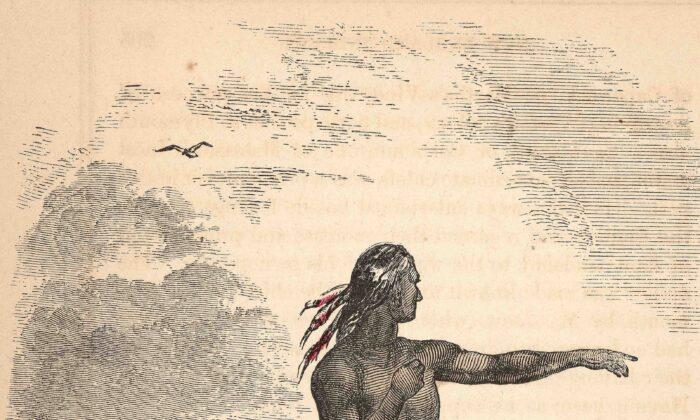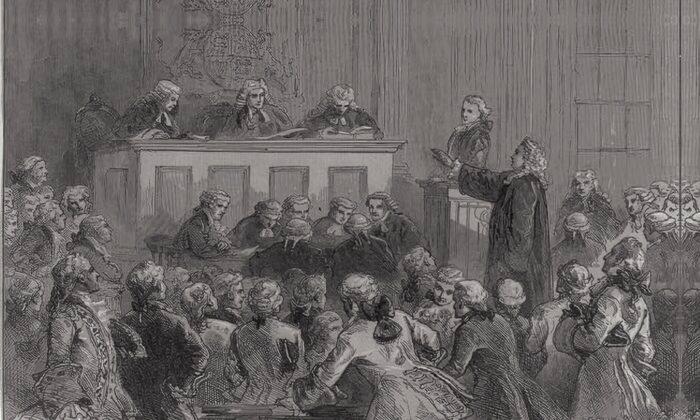In 1614, a Patuxet lad named Tisquantum was kidnapped by English explorer Thomas Hunt. The Patuxet lived in what would later be called coastal Massachusetts, one of many bands spread out over scores of villages and towns collectively organized as the Wampanoag Confederacy.
Tisquantum was never seen by his people again.
Not long after the kidnapping, a devastating disease swept through the region. Tens of thousands of American Indians—indeed, the vast majority of the area’s native inhabitants—perished. Now, entire villages lay completely empty. One of them was a seaside community that had previously been home to the Patuxet. An eerie quiet fell upon the place. Six years passed.
When the Mayflower landed at a location its passengers—the Pilgrims—called New Plymouth, the ship was actually landing at the now-empty site of the forsaken Patuxet village, completely reclaimed by nature since the time of the plague. Pilgrim leader William Bradford described the area as “a hideous and desolate wilderness, full of wild beasts and wild men.”
Allies for the Tribes
Things worked out a little differently at Plymouth. One reason for this may be that the tribal confederacy of the area—the Wampanoag—was in sore need of allies against its long-time enemies, the Narragansett, centered to the west in present-day Rhode Island. The most powerful of the Wampanoag tribes was the Pokanoket, whom the explorer Giovanni da Verrazzano had encountered way back in 1524. “These people,” he reported at that time, “are the most beautiful and have the most civil customs we have found on this voyage.” Once, the Pokanoket had been powerful, but since the plague, they had been reduced to paying tribute to the despised Narragansett.Now, the Pokanoket, led by their chief, Ousamequin (also known as Massasoit), looked to the English at Plymouth as potentially useful allies against their tributary masters. Thus it happened that in the spring of 1621—after a devastating first winter, when so many of Plymouth’s recently arrived colonists had died frozen and starving—a native man approached the settlement. His name was Samoset. He asked for beer.
Samoset was a native chief from farther north (present-day Maine), beyond Wampanoag territory, who had been in the area to visit Ousamequin. Having learned a little English through his interactions with European fishermen, Samoset spent the night with the Pilgrims and, later, tried to get them to trade with him for furs. (On this occasion, his hosts declined; it was the Sabbath, after all.)
Squanto‘s Sojourns
After being kidnapped seven years earlier by Thomas Hunt, Tisquantum was carried to Spain and subsequently sold as a slave on the Iberian Peninsula. Eventually purchased by a group of monks (who bought him for the purpose of freeing him), he was educated for a time in Spain before making his way to London, where he was able to secure passage back to his homeland by promising to be a guide. However, after arriving in America, he abandoned the exploring party who had hired him and made straight for his home village.He found it completely wiped out by the plague. Gone. No one left. Tisquantum had been in Europe during those terrible years of sickness and death. He was, he discovered, the last of his people, the Patuxet.
Indeed, the abandoned Patuxet site on which Plymouth had been erected had once been the summer village of Tisquantum’s very band! Meanwhile, the mighty Pokanoket, he saw, had been reduced to lowly tributary status. Unsure where to go, Tisquantum decided to join himself to Ousamequin and his people. It was Tisquantum, apparently, who had helped to convince the Pokanoket leader that perhaps the English who had just arrived at Plymouth might be useful allies.
- They taught the colonists how to grow corn.
- They taught them where to trade.
- They taught them how to forage.
- They taught them how to gather and prepare herbal medicines.
- They taught them how to build dams for fishing.
- They taught them how to use fish as a fertilizer.
That autumn, the Pilgrims prepared a traditional English banquet to celebrate the harvest—and invited Ousamequin. The Wampanoag head showed up with almost 100 hungry compatriots—to say nothing of five freshly slaughtered deer. Three days of feasting followed. Perhaps the two groups would be able to live in harmony.
Like so many of his people before him, Tisquantum died of fever in 1622, but by then, and thanks to him, an alliance had been forged and 40 years of peace secured. That peace would ensure the survival of this first Puritan enclave in America.
This article was originally published in American Essence magazine.





